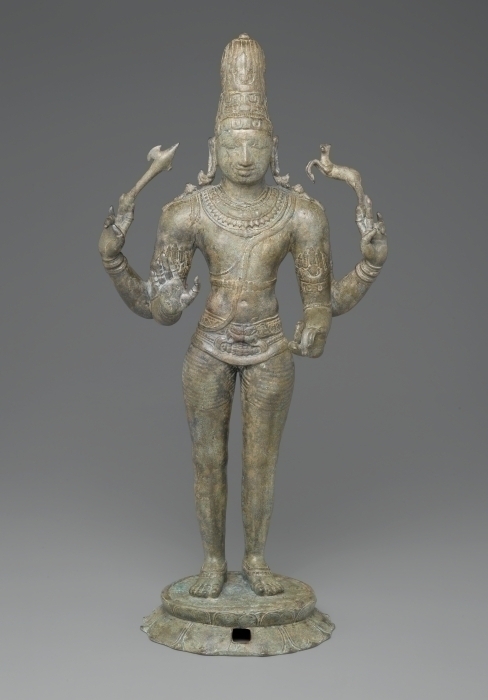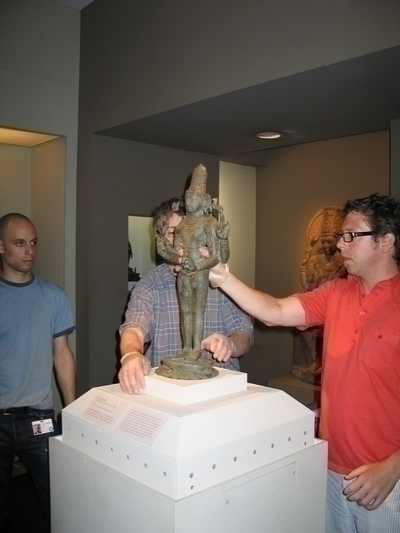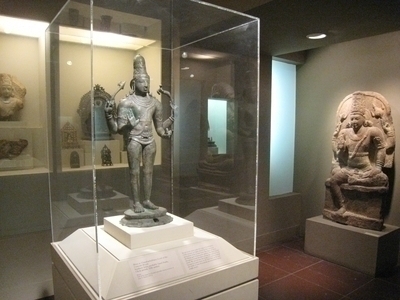Purchasing a Major Work of Art for the Collection – part VII
I can’t believe that it’s been more than a year since my last posting on this topic. I guess I got distracted by other tasks. I was recently asked to “wrap it up,” so here it goes…
In my first installment, I mentioned that no curator shops alone. The official process for adding an object to a museum collection really underscores that idea. It’s that final process, known as “accessioning,” that I’m going to talk about here.

Shiva as Chandrashekhara. Southern India. Chola period, c. 970 A.D. Bronze. Height 25 in. Brooklyn Museum. Gift of the Asian Art Council and other donors in honor of Amy G. Poster, 2007.2.
After we were offered the Shiva by a well-known New York dealer, I had a few people join me on a visit to his workspace to see the object. In our group were the curator emeritus whom the object was going to honor, the co-Chairs of the group of supporters who were largely responsible for funding the purchase, the former Chair of the group (who happens to know a great deal about Indian sculpture), and our senior object conservator (Lisa Bruno, a fellow Brooklyn Museum blogger). All of us were looking for different things, especially the conservator, who wanted to make sure the Shiva wasn’t actively deteriorating and who was looking for signs of major repair or tampering that might have compromised the authenticity of the object.
Once the Shiva passed all our criteria, we told the dealer to “hold” the piece for us and we asked for photographs. I rushed back to our Director, Deputy Director, and Chief Curator and showed them the photos while also making a pitch for why the object would make such a good addition to the collection, how we could use it in various different types of exhibitions, why it was an appropriate acquisition to honor Amy, etc. They seemed impressed. Had they not been impressed, it would have been pretty difficult for me to move forward with the purchase. I have had directors reject objects that I really, really wanted, and while it seemed terribly unfair and somewhat arbitrary at the time one has to remember that the Director has broad experience and really is just looking out for the wellbeing of the Museum.
Only after I got their go-ahead did I arrange for the object to come to the Museum. We generally try not to have works of art delivered to the Museum unless we are quite sure that we want them. The Museum usually has to foot the bill for returning the objects we decide not to acquire, and packing and shipping of works of art can get pretty expensive.
After the object arrived at the Museum, it received further inspections by conservators and administrators while I generated the official paperwork to present it to our Collections Committee. Most art museums have a Collections Committee, comprised of members of the Board of Trustees and sometimes other high-ranking constituents. The Committee is tasked with keeping the Museum on track with the kind, quality, and number of objects it acquires (and disposes — more on that later). The Committee looks at gifts as well as purchases.
The curators and Director wouldn’t present anything to the Collections Committee without a strong sense that it should be added to the collection, but the Committee is there as a final check on the Museum staff, to make sure that we haven’t overlooked a serious problem with the object or the terms of its acquisition. They meet several times a year to look at, and vote on, the latest batch of acquisitions. Only after the Committee has voted can an object be added officially to the collection.
After the Collections Committee meeting, and only after the meeting, the Museum cuts a check for the vendor. Sometimes—often—many months pass between the day the curator first expresses interest in a work of art and the day the dealer receives any money for it. Dealers are willing to put up with the delay because of the prestige of having sold an object to a museum. But there are certainly situations in which a Museum loses out on an object because a private collector can pay for it on the spot and the dealer really needs the cash.

Designer Lance Singletary works with Brooklyn Museum Art Handlers to install Shiva as Chandrashekhara.
After the object has been approved by the Committee, it is assigned an accession number (you’ll notice these associated with all of Brooklyn’s objects; they start with a 2-digit or 4-digit date) and a location in storage. In an ideal world we would put all our new acquisitions out on view immediately after they arrive, but installing works of art in a public gallery costs quite a bit of money. Sculptures often need mounts made, pedestals built, etc. It seems kind of tacky, but sometimes we have to tell a potential donor that we can’t accept their work of art as a gift unless they also give us the cash to pay for its installation. Museum casework has to ensure proper climate and security, and an apparently simple pedestal with a Plexiglas bonnet can cost several thousand dollars. Luckily, we already had a pedestal in the Indian gallery that was just right for our Shiva, and he didn’t need any fancy mount because his base sits flat and steady. So we moved him into the gallery shortly after we acquired him and we don’t have any plans to move him in the future, so he’s probably there right now.
A final word on the accessioning process: it is slow, involves a lot of paperwork, and requires the efforts of dozens of individuals, but it is designed to make sure that we are serious, cautious, and deliberate in our intake of art objects. Every art museum (there may be one or two exceptions) has junk in storage. The majority of it was given, rather than purchased. Often the curator knew or suspected it was junk but accepted it anyway because they didn’t want to offend the donor. There’s something to be said for cultivating long-term relationships with donors, but storage space is finite and we’re supposed to treat all objects with a very high level of care that can be a burden on the budget and staff time. So nowadays we are pretty hardcore about what we accept. And like most museums, we do some deaccessioning, or removal of objects from the collection.
Probably most of you have read news stories criticizing museums for selling off great works of art from their collections. Even when deaccessioning is handled properly (with proceeds used only to support future acquisitions of works of art), it can be newsworthy because a community experiences a loss of “cultural heritage” when a beloved masterpiece leaves the area or leaves the public domain. What you don’t hear about in the press is the far greater number of not-so-great works of art that leave museum collections on a pretty regular basis. And you also don’t hear just how much work museums have to put into the process of releasing objects, many of which will fetch three figures on a good day. We have numerous people from several sectors sign off on the release (including the Collections Committee), we put considerable effort into finding appropriate homes for the objects in other public institutions, and then if we do sell we prefer to do so at auction so the transaction can be as public as possible even though an auction might not be the most lucrative venue for sale. In short, deaccessioning is a laborious and mostly unrewarding process and the aim of the curator is to take in as few future deaccessions as possible.

Let’s not end this long series on a grim note! Instead, please let me encourage you to visit the Asian Art galleries, on the second floor of the Brooklyn Museum. We’re gradually getting more and more of the collection out onto the web, but really nothing beats seeing the objects in person. One of the great things about an in-person visit to a museum is the happy accidents—you go to see a specific show or work of art but you catch sight of something you’ve never seen or heard of before and it becomes the thing you remember, the object that changes your outlook in some way. So come visit our Shiva, and maybe you’ll find some other works of art that are even more exciting.

Joan Cummins is the Lisa and Bernard Selz Curator of Asian Art at the Brooklyn Museum. Joan received her Ph.D. in 2001 from Columbia University. Prior to coming to Brooklyn, Joan served as Assistant Curator of Indian, Southeast Asian, and Himalayan Art at the Museum of Fine Arts, Boston. Her most recent book is an introduction to Indian painting, published in 2006 by the MFA, Boston. Joan was a Research Associate in Brooklyn's Department of Asian Art from 1991-1993.
